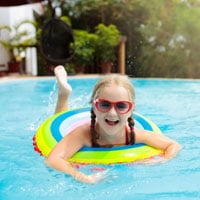Dry Drowning and Secondary Drowning
 Summer is the high season for water sports and recreation, and every parent should be aware of the risk of dry drowning and secondary drowning for young children. Thankfully, occurrences are rare but for those affected, these conditions can be fatal if the warning signs are not recognized immediately.
Summer is the high season for water sports and recreation, and every parent should be aware of the risk of dry drowning and secondary drowning for young children. Thankfully, occurrences are rare but for those affected, these conditions can be fatal if the warning signs are not recognized immediately.
Dry Drowning
Dry drowning occurs on land after water has been inhaled through the nose or mouth. The water triggers spasms in the vocal cords and the airways start to close off making it difficult to breathe. A child who leaves the water with a persistent cough or has trouble taking in air should be seen by a doctor immediately. It is important to treat the situation as a medical emergency.
Secondary Drowning
Secondary drowning differs from dry drowning in that water taken into the body ends up in the lungs and starts to build up making it difficult to breathe. This can take hours to happen; therefore, the symptoms are sometimes not associated with having been in the water. Often large quantities of water are taken in by people who have experienced a near drowning and as such, symptoms of secondary drowning are mistaken for exhaustion. Warning signs of secondary drowning include:
- Coughing or trouble breathing
- Irritability, drowsiness or a drop in energy level
- Chest pain
- Vomiting
A child exhibiting any of these symptoms should be examined immediately, even if symptoms seem mild. Often they will improve, but if they do not, a pulmonary edema could develop. There have been rare cases of children dying a day or two later after swimming.
To recognize the signs of secondary drowning, parents must monitor their child’s behavior after a day of swimming where the child may have inhaled water. Many times, lethargy is mistaken for fatigue from a near-drowning experience or a long day of swimming.
Prevention of Dry Drowning and Secondary Drowning
Fortunately, swimming pool accidents that can lead to dry drowning and secondary drowning are both preventable. There are many steps parents can take to reduce the risk of dry drowning and secondary drowning incidents. These include:
- Teaching children to swim as early as possible
- Teaching children water safety at a young age
- Always monitoring young children near water sources whether it is a play pool, bathtub, or large body of water
- Frequenting only locations with lifeguards
- Prohibiting horseplay in and around water
Under premises liability laws, pool owners must maintain a safe environment for visitors to private and public pools. Known safety hazards that are left unremedied and cause others to be injured could be grounds for a personal injury claim. If you or someone you love has been injured in a pool accident including near drowning, dry drowning or secondary drowning you should contact a personal injury lawyer immediately.
New Jersey Personal Injury Lawyers at Eichen Crutchlow Zaslow, LLP Advocate for Victims of Pool Accidents
Contact the experienced New Jersey personal injury lawyers at Eichen Crutchlow Zaslow, LLP if you have been injured in a pool accident caused by the negligence of another party. We can help you determine your best legal course of action to obtain compensation. Call us at 732-777-0100 today to schedule a free consultation or contact us online. From our offices in Edison, Red Bank, and Toms River, we provide skilled representation to injury victims throughout the state of New Jersey.

Eichen Crutchlow Zaslow, LLP has purposely remained small in size, because it is important to us that we get to know our clients and their needs. Larger NJ injury firms may churn out case after case, but that’s not how we operate. Partners Barry Eichen, William Crutchlow, and Daryl Zaslow have created a firm with the resources to handle complex litigation, and a team that takes your case personally.
Find out more about Eichen Crutchlow Zaslow, LLP
